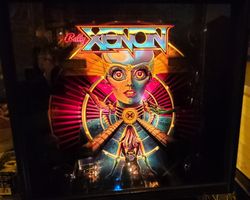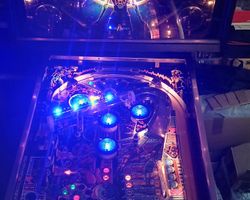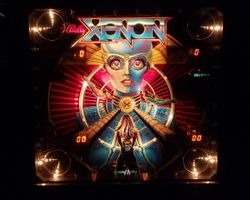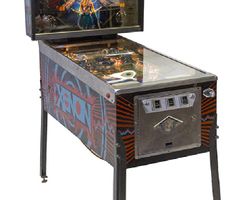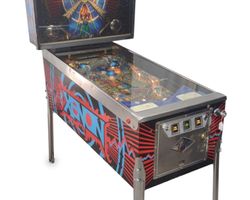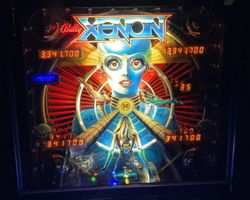Xenon
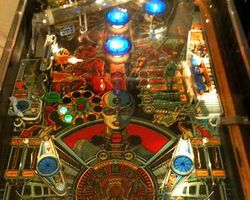
Average Prices: USD $400 to $2,300
Produced: November, 1980
Production Run: 11,000 units
Machine Type: Solid State Electronic
MPU: Bally MPU AS-2518-35
Players: 4
Design by: Greg Kmiec
Art by: Paul Faris
Music by: Suzanne Ciani
Sound by: Suzanne Ciani
The allure of arcades in the late 1970s and early 1980s was often defined by the vibrant glow and cacophonous symphony of pinball machines. Among these, the "Xenon" pinball machine emerged, a striking creation from Bally Manufacturing Corporation, which carved out a distinct place in the annals of pinball history. Released in November 1980, Xenon captivated players with its blend of sci-fi aesthetics and technological innovation, becoming a touchstone for solid-state pinball design.
History and Background
Bally Manufacturing Corporation, a dominant force in the pinball industry, introduced Xenon as model number 1196. The machine's theme was a departure into a sleek, futuristic world, blending elements of science fiction with an ethereal, almost fantastical, feminine mystique. This vision was brought to life through the collaborative efforts of a focused design team. Greg Kmiec, a prolific designer for Bally, conceived the gameplay layout, while Paul Faris, celebrated for his distinctive artistic style, provided the captivating artwork that adorned the cabinet, backglass, and playfield. The software, which orchestrated the machine's intricate functions, was developed by Rehman Merchant.
However, a pivotal and truly groundbreaking contribution came from electronic music composer Suzanne Ciani, who was responsible for all the music, sound effects, and, notably, the custom speech featured in Xenon. This marked a significant milestone, as Xenon was not only the first talking Bally pinball game but also the very first pinball machine to feature a female voice. Ciani’s unique vocalizations, described as sensual and atmospheric, permeated the gameplay experience, drawing players deeper into the machine's futuristic narrative. The integration of speech was enabled by Bally's innovative AS-2518-56 sound board and the AS-2518-57 "Vocalizer" board, a departure from their later "Squawk and Talk" system.
Xenon saw a substantial production run of 11,000 units, indicating its immediate popularity and Bally's confidence in the design. During its development, Bally experimented with cost-saving measures, including an experimental playfield overlay where artwork was printed on Mylar and then affixed to the playfield. This approach, however, presented challenges in accurate application around routed boards and glued inserts, leading to the adoption of a more traditional production process for the final version. Paul Faris refined the artwork for the production run, ensuring its visual quality.
Signature Features and Design
The defining elements of the Xenon pinball machine extend beyond its visual appeal and into its core mechanics and audio-visual presentation. The most immediately recognizable feature is the "Xenon tube," an elevated, clear plastic ramp that starts on the right side of the playfield and guides the ball across to a lane on the left. This innovative physical element was not merely decorative; it was central to the game's identity and provided a satisfying, high-reward shot. The tube shot, a visual and tactile spectacle, became synonymous with Xenon and offered a unique ball trajectory not commonly seen in solid-state pinball machines of the era.
Another signature element was the revolutionary custom speech, meticulously crafted by Suzanne Ciani. The game’s soundscape was rich with futuristic tones and the distinctive female voice, which delivered callouts that guided players, celebrated successful shots, and built tension. This integration of human speech added a layer of immersion and personality to the machine previously unattainable with standard chimes and electronic bleeps.
Visually, Xenon distinguished itself with its striking backglass, featuring a stylized woman intertwined with sci-fi elements. Behind this art, Bally implemented "infinity lights," a clever arrangement of mirrors and illumination that created a mesmerizing tunnel effect, drawing the viewer into an endless void. This visual trickery enhanced the machine’s futuristic theme and provided a captivating backdrop to the gameplay. Coupled with the vibrant playfield artwork, which blended cosmic imagery with mechanical components, Xenon presented a cohesive and highly artistic package. The combination of the tube, the speech, and the infinity lights created a sensory experience that was both innovative and captivating for its time.
Playfield and Mechanics
The Xenon playfield layout is a testament to Greg Kmiec’s design philosophy, balancing open areas for fluid ball movement with strategic targets that demand precision. The lower playfield is anchored by two flippers, positioned for optimal control and shot execution. Above the flippers, two slingshots on either side provide dynamic ball redirection, keeping the action lively.
The upper playfield is dominated by key scoring opportunities. A prominent feature is the single ramp on the right side that leads into the clear Xenon tube. Successfully shooting the ball up this ramp and through the tube is a primary objective, and the visual of the ball traversing the transparent tunnel is a constant draw. Upon exiting the tube, the ball feeds into a left-side lane, preparing it for subsequent shots.
Scattered across the playfield are four pop bumpers, positioned to create chaotic, unpredictable ball movement, often leading to unplanned shot opportunities or quick drains. Two kick-out holes offer rewards for precise shots, ejecting the ball back into play or toward a flipper. A bank of four drop targets provides a clear objective, requiring players to knock down each target to earn points or activate features. Additionally, there are four mini-rollover buttons and two standup targets, offering further scoring avenues. A spinning target also provides a highly satisfying tactile and auditory experience upon striking.
The artwork on the playfield, by Paul Faris, seamlessly integrates with the theme, depicting cosmic elements and machine components. The lighting across the playfield, while characteristic of solid-state machines of the era, was effectively utilized to highlight key areas and emphasize the futuristic aesthetic. The overall design philosophy aimed for an engaging experience that was both visually stimulating and mechanically rewarding, with the tube shot serving as the central attraction and a clear target for players to pursue.
Gameplay Dynamics
The gameplay dynamics of Xenon revolve around a clear, albeit focused, set of objectives that were characteristic of early solid-state pinball machines. The primary goal for players is to repeatedly achieve the iconic tube shot, which not only yields significant points but also progresses game features. Successful shots through the tube illuminate indicators and advance towards activating the game's two-ball multiball.
Multiball, a highly sought-after feature in any pinball machine, is a key strategic element in Xenon. When two balls are in play, the scoring potential dramatically increases, and the chaos on the playfield intensifies, demanding quick reflexes and precise control to keep both balls in play and maximize points. Players often aim to trap one ball on a flipper to control the second, allowing for more precise shots.
Beyond the tube, other objectives contribute to scoring and flow. Hitting the bank of four drop targets is essential, often revealing a hidden lane or triggering bonuses. The spinning target offers a rapid accumulation of points, rewarding repeated hits. Mini-rollover buttons and standup targets provide consistent point opportunities throughout the game. While the scoring system can sometimes feel weighted towards the tube shot, the interplay of these various elements provides a dynamic challenge. The maximum displayed point score per player is 9,999,990, encouraging high-scoring endeavors. Player strategies often involve mastering the trajectory required for the tube shot, then capitalizing on the multiball phase to rack up significant scores. The fast pace and the allure of the tube shot encourage repeated plays, with players continually striving to perfect their aim and extend their game time.
Reception and Legacy
Upon its release, and in the decades since, Xenon has garnered a varied but predominantly positive reception within the pinball community. Its strengths are frequently highlighted, particularly its visual and auditory presentation. The artwork, especially Paul Faris's captivating backglass, is often cited as one of the most aesthetically pleasing of its era, described as mysterious and seductive. The cabinet design and the effective use of chase lights further contributed to its visual appeal.
The sound design by Suzanne Ciani is consistently praised as groundbreaking. The inclusion of a human voice, especially a female one, was a significant innovation for 1980, creating an atmosphere that was both unique and immersive. Players recall the tension built through the integration of sound and lighting, and the distinct callouts remain memorable. The tube shot is almost universally lauded as a fun and rewarding mechanism, providing a unique challenge and visual spectacle. Many enthusiasts appreciate Xenon for its historical significance, recognizing it as a pioneer in speech integration and early multiball implementation. For those who encountered it in their youth, the machine holds a strong sense of nostalgia. Its simpler rule set, when compared to modern games, is sometimes seen as a strength, offering a straightforward yet challenging experience.
However, Xenon is not without its acknowledged limitations. Some players found the core gameplay, while rewarding, could become repetitive, feeling that the game sometimes leaned too heavily on the tube shot. The ruleset is considered basic by some, lacking the depth and complexity of later designs. Certain players also noted the game's tendency for fast drains, leading to short play times. Over extended periods, the distinct music and voice callouts, while innovative, could become repetitive or even annoying to some ears. The scoring system is occasionally criticized for being too focused on specific shots, potentially leading to an unbalanced feel.
Despite these points, Xenon’s legacy remains robust. It is recognized as a pinball icon, not just for its sales numbers, but for its role in pushing the boundaries of what solid-state pinball could achieve in terms of sensory engagement. Its unique blend of art, sound, and a central playfield gimmick ensured its place in pinball history. It stands as an important example of early speech integration and a machine that dared to break from conventional sound design, influencing future generations of pinball machines to incorporate more sophisticated audio elements. For many collectors, Xenon is considered an essential acquisition, representing a pivotal moment in pinball's evolution.
Sponsored Links
 Ebay Listings
Ebay Listings
 Auction Results
Auction Results
| Cost | Location | Date |
|---|---|---|
| GBP £1,361 |  Kingswinford, United Kingdom Kingswinford, United Kingdom |
22 October, 2025 |
| EUR €2,750 |  Nordrhein-Westfalen, Germany Nordrhein-Westfalen, Germany |
22 July, 2025 |
| USD $500 |  Michigan, United States Michigan, United States |
21 June, 2025 |
| USD $3,800 |  Texas, United States Texas, United States |
11 June, 2025 |
| USD $4,000 |  Pennsylvania, United States Pennsylvania, United States |
26 April, 2025 |
| USD $2,500 |  Maryland, United States Maryland, United States |
08 April, 2025 |
| USD $4,399 |  United States United States |
29 March, 2025 |
| USD $750 |  Maryland, United States Maryland, United States |
18 January, 2025 |
| USD $750 |  Maryland, United States Maryland, United States |
18 January, 2025 |
| USD $1,800 |  Pennsylvania, United States Pennsylvania, United States |
17 January, 2025 |


Private Policy · Search Website · Contact Us
As an eBay Partner, we may earn a commission from qualifying purchases made through links on this site, at no additional cost to you.
All trademarks and copyrighted materials remain property of their respective owners. All other content copyright 2007 - 2026 Pinpedia.

